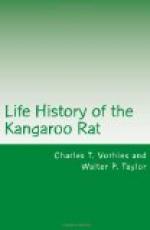Some stored material is likely to be found at any time of year in any mound examined, the largest quantity usually in fall and winter, the smallest in July or August (Table 1, dens 1, 2, 14, and 24). Amounts found by different observers vary from a few ounces to several quarts or pecks, and stored materials taken from 22 mounds on the Range Reserve vary in weight from 5 to 4,127 grams (more than 9 pounds). This is exceeded by one lot from New Mexico, which totaled 5,750 grams (12.67 pounds). It is fairly evident that in seasons of scanty forage for stock the appropriation of such quantities of grass seeds and crowns and other grazing materials by numerous kangaroo rats may appreciably reduce the carrying capacity of the range. Studies of cheek-pouch contents and food stores taken from dens show that the natural food of spectabilis consists principally of various seeds and fruits, particularly the seeds of certain grasses. The study of burrow contents has been especially illuminating and valuable.
All of the stored material from 22 dens on the Range Reserve and from 2 near Albuquerque, N. Mex., has been saved and analyzed as to species as carefully as the conditions of storage would permit. Within the mound the food stored is usually more or less segregated by plant species, though the stores of material of any one kind may be found in several places through the mound, and often the material is mixed. In the latter case the quantities of the various species can only be estimated, but in the former the species may be kept separate by the use of several bags for collecting the seeds, and a fairly accurate laboratory weighing can be made later. Very frequently, the explanation of this separation of species lies in the different seasons of ripening, but sometimes where two species are ripe at the same time near the mound, one is worked upon for a time to the exclusion of the other. The one kind is often packed in tightly against the other, but with a very abrupt change in the character of the material.
A number of the more interesting and representative results of the weighing and analyses of burrow contents are presented herewith in tabular form. The data for each den, or lot, shows in grams the quantity of stored material removed and the best estimate it was possible to make of the percentages or weights of the various species. When the weight was less than 5 grams, the mere trace of the species frequently is indicated in the following tables by the abbreviation “Tr.”




